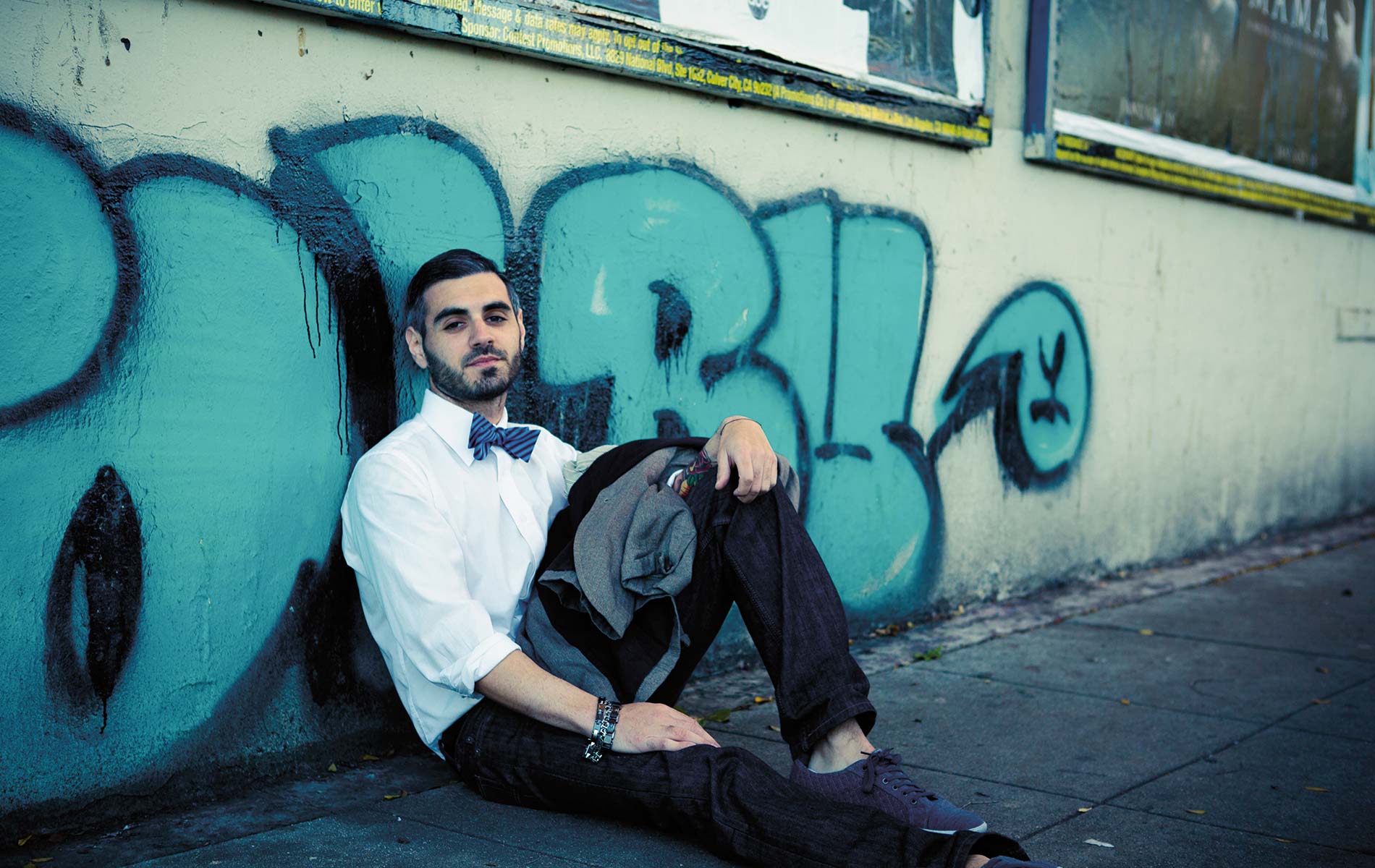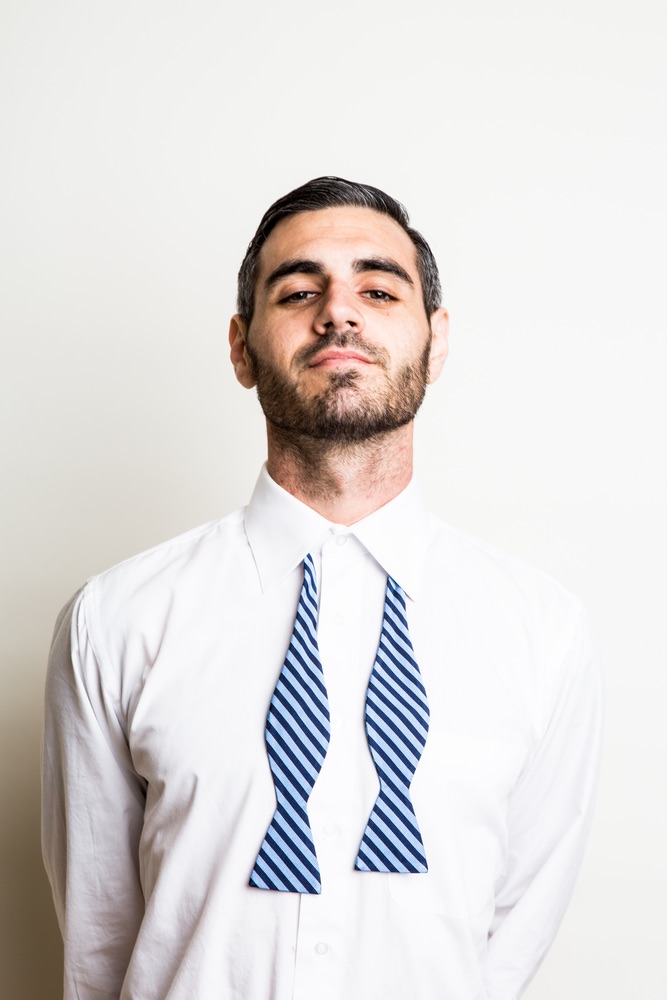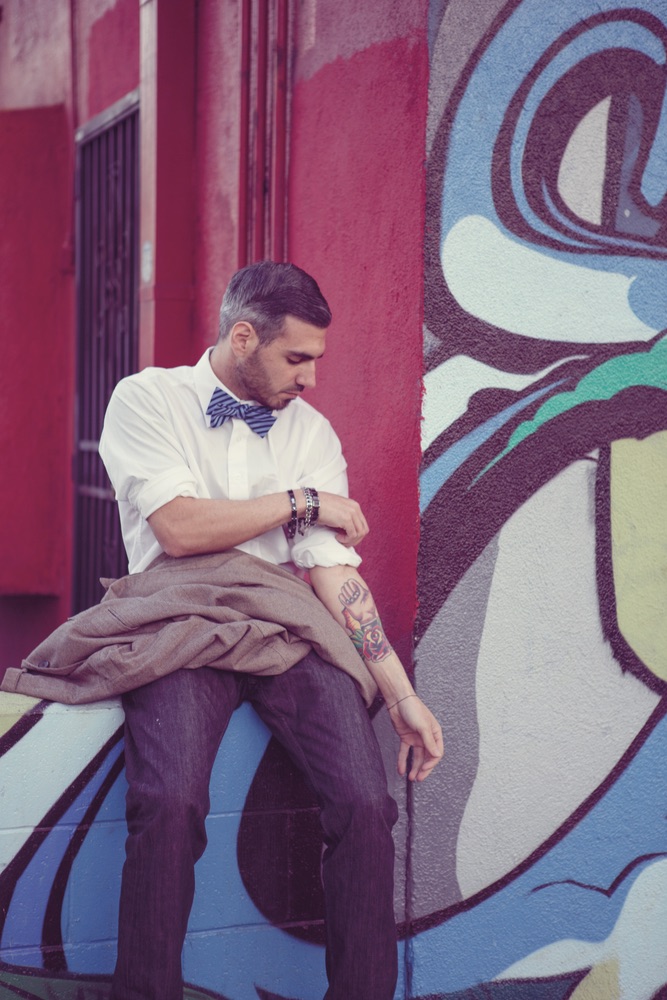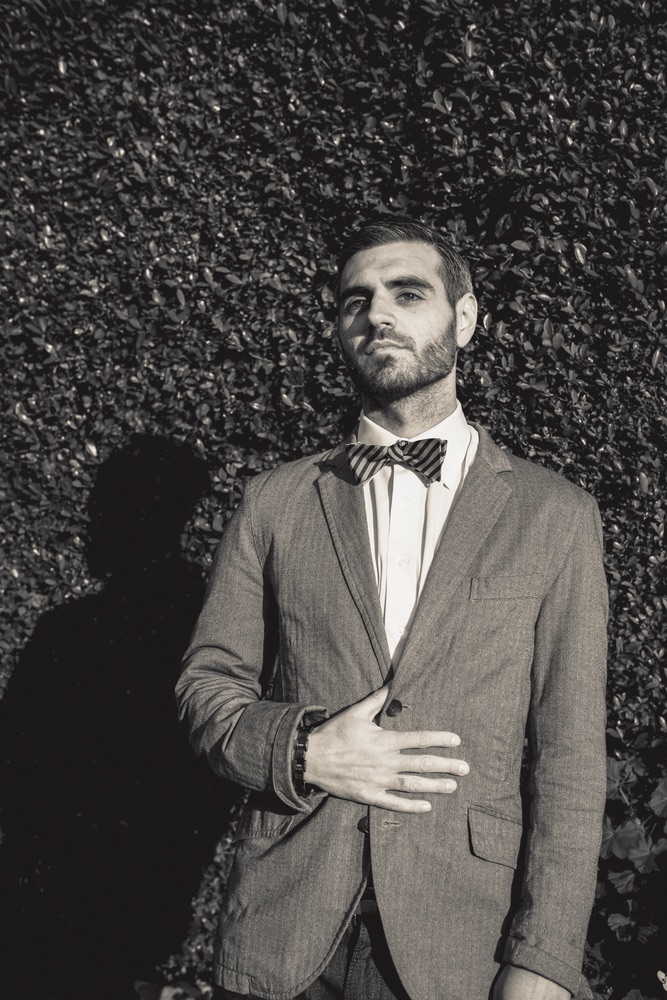
vie-magazine-greg-cayea-hero
The Therapy of Writing
Sharing Life Lessons
By Chad Thurman | Photography by Mark Pallermo
Blogger, writer, illustrator, and peripatetic soul Greg Cayea is a storyteller. He sees the iridescent, ever-changing world through an augmented lens with a black-and-white filter—and that’s just fine with him.
At age thirty-two, Cayea looks back on a young life that began much the same as any other American suburban kid’s life does—full of listless confusion and vigorous ennui. However, at only fourteen and with spirits that he had stolen from his parent’s wine cellar, he began drinking alcohol to cope with the awkwardness of growing up.
This early relationship with alcohol eventually led him to a juvenile corrections facility that has since been shut down because of its abusive policies. Cayea eventually escaped from that facility and began the life of a vagabond who now holds a Guinness World Records title for the world’s longest road trip in a single country.
Despite his tumultuous beginnings, Cayea rose to success as an impresario, a small business entrepreneur, and a published author. He has also become one of the most popular Internet bloggers of today through sharing his story. “As a kid, I was desperate for friends, so I did whatever it took to get them,” he says. “And that led me down a really dark path that led to situations with some really dark people until I just kind of lost it and got buried under a sea of drug addiction and dangerous situations. I was eventually kicked out of school and sent to an institution in the mountains of North Georgia called Hidden Lake Academy.”
Cayea’s first book, No Direction Home: The Drifter Chronicles; Volume 1, tells the story of how he ended up at Hidden Lake Academy, a “boot camp” type of facility that treated its young residents very poorly—and no one seemed to know or even care.
Cayea says that since he has told his story, he has gotten a lot of feedback from others relating how he helped them cope with their pasts. “I find the truth to be far more interesting than fiction, which is why I never write fiction,” Cayea says. “The book is about how I ended up in the most infamous juvenile institution in America, what it was like being there, and how I escaped.”

When he left that institution at sixteen years of age, Cayea lived on the road and on the run, and as he puts it, he “never went back.” He lived a nomadic life until very recently, when he moved back home to Long Island, New York, to make up for lost time with his family.
According to Cayea, these types of juvenile institutions, often masquerading as “therapeutic boarding schools” or “behavior modification centers,” could once be found all over the country, though most have been shut down because their unsavory practices were exposed.
“These places were . . . weird,” he says, “and for me—and many others—being there was the start of a massive disconnect between me and everybody else that I had grown up with, and pretty much everybody in my life.”
Google Hidden Lake Academy or search for any facility of the same type, and you’ll find what Cayea calls “survivor groups” all over the Internet. You’ll find rumors, horror stories, lawsuits, and discussion forums full of people bickering back and forth about what happened there. Cayea’s book walks you through what it was like and what actually happened at these facilities.
“I find the truth to be far more interesting than fiction, which is why I never write fiction. The book is about how I ended up in the most infamous juvenile institution in America, what it was like being there, and how I escaped.”
“I’ve searched for and could not find one story ever written about any of these schools,” Cayea says. “I think my book is the first firsthand account of what happened at these facilities. Moreover, I think that a lot of people—at least tens of thousands of former ‘students’ that are now adults—are appreciative that someone finally got the word out there about what they went through as kids. It’s a hard kind of tale to tell. Most of my friends that are still alive and out of prison who went to these places feel the same way, or at least they did for a very long time.”
Cayea doesn’t want the explanation of these difficult circumstances to be taken as an excuse for his behavior, but he says, “It certainly caused a disconnect,” and it kept him on the road. He found that after leaving Hidden Lake Academy, he could not relate well to people because no one he encountered knew of or had openly shared a similar experience.
Then one day, his life took a turn toward clarity, and he began to write about what he had experienced and what he knew. He soon discovered that he was not alone.

“I wrote this book because I got sober six years ago, and at the time, I didn’t know what in the hell to do with my life,” Cayea recalls. “I started writing it the day I got sober, and writing it was what kept me sober. About four years into sobriety, I met a girl in Los Angeles who had found my blog, and she asked me if I would be open to writing a book. I told her that I had been working on one, but it wasn’t complete. It turns out, her brother was a literary agent and her mother an author, and she wanted to package all of us together to help me to finish the book.”
So began the process of finishing No Direction Home: The Drifter Chronicles, but at that time, Cayea had grown tired of writing about himself. Simply put, he didn’t want to talk about his past anymore, as he found it to be “a waste of time.” He felt as though he didn’t have anything unique to say. He had no idea that his writing could be a catharsis for others who were suffering emotionally. “I had moved on,” he says, “and the process of writing wasn’t as therapeutic for me as it once was; however, I had gotten it to the point where I had completed a full draft, so I illustrated and published the entire book.”
“I had moved on, and the process of writing wasn’t as therapeutic for me as it once was; however, I had gotten it to the point where I had completed a full draft, so I illustrated and published the entire book.”
After publishing, Cayea started adding some of the stories to his blog as a “testing ground,” as he calls it. He wanted to see if people would even be interested in what he wrote. “It then became a passion project that I had to do,” he admits. “I put some of the chapters from the book up on my blog and on Facebook to see what the reaction would be, and I started getting these replies and very long e-mails from people. I realized that maybe this story was a little bigger than me.”
People began writing to Cayea thanking him for what he had written. The author was confused at first by all of the new emotionally intimate conversations that complete strangers had begun. Cayea relates that at the time he was thinking, “What could I possibly be helping this person with?” After all, up until that point, he had only viewed his writing as a narcissistic yet therapeutic project to engage in while working through his own life’s turmoil. “As I kept sharing these blogs and posts, I started to realize that there was a whole group of people seeking the honesty of my story. It was as if I were telling their stories for them in a way that was very honest.”

He continues, “The main goal with the book was not to write a masterpiece: it was to make sure that people that generally don’t read could easily share in the experience. I don’t consider myself a writer; I just know that I’ve got good stories to tell, and I know how to tell them. People have called me the ‘reality TV’ of bloggers—for a lot of people, it’s a guilty pleasure to read my blog.”
Cayea is grateful that some of the more memorable e-mails he has received come from people that weren’t sent to one of the corrections facilities; some letters are from people close to those who were there. For the longest time, he says, these people were trying to get inside their loved one’s spirit and mind, trying to figure out what they went through, but just couldn’t understand.
“The first time that I realized that maybe I wasn’t just a jackass writing about myself was when this girl wrote and told me that she had a friend that went through a very similar time with drug use and institutionalization,” Cayea says. “She related to me that when she shared my writing with him, she knew that he was going to be able to relate to me. She told me that he read my blog for a year and had begun to write about his experience. One of the only ways she had to communicate with him was through his writing, which had been inspired by mine.”
“I don’t consider myself a writer; I just know that I’ve got good stories to tell, and I know how to tell them. People have called me the ‘reality TV’ of bloggers—for a lot of people, it’s a guilty pleasure to read my blog.”
Though Cayea relates that it is heartwarming for him to know that he was helping this person, the author goes on to say that, “It was not a happy ending; he eventually committed suicide. She said that he had been depressed for a very long time. She was thankful, though, that in the last year of his life he had found a voice and could express himself. He had at least attempted to address his problems or inner demons or whatever you might want to call them.”
Despite the tragic ending, Cayea says the young woman’s story of her loved one made him feel good, knowing he had helped the young man feel he could express himself and tell his own story.
“Reading his writing is now the only way his friends and family will learn about his life,” Cayea explains. “He had never talked about it, but now there is this body of work that they will be able to read to gain an understanding of who he was.”

As for the aforementioned world-record-breaking road trip, Cayea and his girlfriend at the time, Heather Thompson, surpassed the Guinness World Record for the longest road trip in one country on September 20, 2016. They hit 22,406 miles after 103 consecutive days of traveling the continental United States—and they kept going, finishing their journey with over 36,000 miles traveled in a car.
Cayea points out that he initially conceived of the road trip to promote his book so that he could reach a wider audience and potentially help more people struggling with dark and painful pasts—particularly those laced with the disconnect caused by addiction.
Cayea points out that he initially conceived of the road trip to promote his book so that he could reach a wider audience and potentially help more people struggling with dark and painful pasts—particularly those laced with the disconnect caused by addiction.
“I’m in life for the adventure,” Cayea says, “I thought to myself, ‘How can I get the world’s attention?’ So, I did this road trip to promote the book. I figured that I could position myself as an authoritative traveler, and then maybe people would want to know how this all got started, which is essentially what my book is about.
“Before the road trip, I was having a hard time because I felt like I had done it all, and I wanted to do something big and grandiose. That is part of what led me to the record-breaking idea. Knowing that I was about to launch a journey that could help other people is what revved my engine.”
— V —
To learn more about Greg Cayea, his book, and his popular adult and PG-rated blogs, visit ScrambledGregs.com. To read Cayea’s firsthand account of his Guinness World Record–breaking road trip, check out the article “Spinnin’ Your Wheels” from the VIE August 2017 issue at VIEmagazine.com.
Share This Story!
KEEP UP WITH THE LATEST STORIES FROM VIE

































































































































